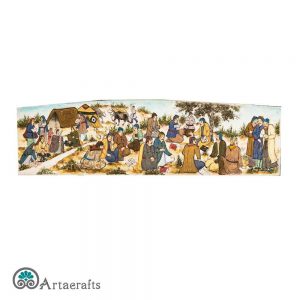The history of painting in Iran:
Prehistory painting in Persia:
The most important painted pictures in Iran have been excavated in the west and in Lorestan. Most of these pictures show scenes of battle, hunting, man and animal. Vestige of painting were seen on the earthen ware objects. The artists also exhibited their works on metal articles.
Painting during the Achaemenian dynasty:
If you take the relief pictures of Persepolis into consideration, you can see an interest in deep colours and a taste for elaborate work which is the fundament of a Persian art. There are murals with glazed bricks in Apadana (Persepolis) and a part of Susa palace. Achaemenid art cared for the decorative aspects of drawings.
Painting during the Arsacids (Parthians) dynasty:
In Arsacid art Painting was very important. Most relief drawings of this period was of type of design and drawing. The most famous drawing of this type is in Khaje mountain where the Persian and Greek arts are mingled together. One of the particulars of these drawings is applying black lines for drawing through using tools and lacking shade in colours.
Painting during Sassanian dynasty:
There are a lot of reports in books of history and log in that period on Painting. Among the sites where painting vestiges are seen is Madayen veranda (Tagh-e Kasra). The beautiful drawings of cloths and carpets of the sassanid also show the flourishing and prevalence of drawing art in that period. The art of bookmaking and decorating it with paintings reached the acme of evolution.

